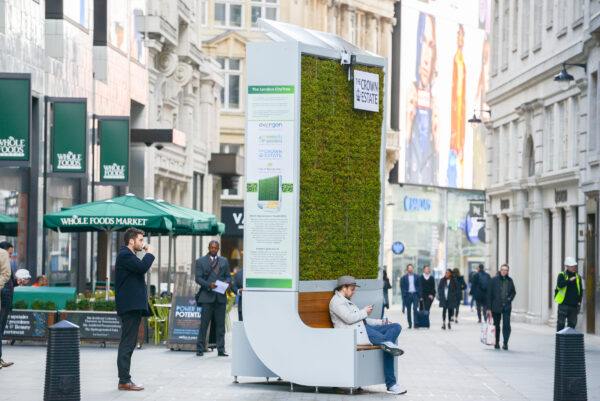A mechanical pollution absorbing “tree” has been installed on a side street near Piccadilly Circus as an experiment to improve local air quality.
Said to be able to deliver the pollution reducing and air cooling effect of 275 conventional trees, this block of greenery is actually a special combination of mosses and plants.
With a park bench in the base.
The London trial will see City Tree tested on the streets of the West End, and comes following launches in cities across Europe.
The technology has been developed by Green City Solutions in Germany and is billed as the world’s first intelligent biological air filter. It works by creating an environment for specially cultivated mosses to thrive in urban conditions. The ability of certain moss cultures to filter out and absorb air pollutants such as particulates and nitrogen dioxide makes them ideal air purifiers – but in towns and cities where air pollution presents the greatest challenge, mosses are barely able to survive, due to their need for constant water and shade.
The vertical living wall of mosses with protective shade giving plants, a fully automated supply of water and nutrients has solved this problem. At the same time, air quality, filtering performance and the plants’ requirements can be remotely monitored and analysed.
The installation powers itself via solar panels, and rainwater is collected and automatically redistributed using a built-in irrigation system.
Each CityTree is said to be capable of reducing particulate matter by up to 30%. The wall of irrigated mosses also produces a cooling effect on the surrounding area, which is one of the benefits of conventional trees, in that they not only cast shade, but their living process creates an active air cooling effect.
The technology behind the “City Tree” is a result of over 10 years research at the Dresden University of Technology, Lancaster University and the University of Bonn.
While it is undeniably better to prevent pollution in the first place, the CityTree has usually been installed in locations where pollution is high, but also due to local buildings, airflow is low — creating a pollution bubble that people need to walk through.
The CityTree can be found on Glasshouse Street, just off Piccadilly Circus.








It would be great if these lined the main roads in London, especially along the cycle routes
… or they could just plant the trees?
Might struggle to fit 275 trees in a road that size though — this gadget seems to be aimed at pollution hotspots, essentially concentrated tree-power in a location that doesn’t have space for normal trees.
Looks like we’ll be getting one in Putney High Street soon too. Excellent.
Trees only absorb carbon dioxide… al other chemical pollutants only stick to aberrations on the tree’s bark and leaves. Trees do not absorb NOx or sulphur dioxide or benzene or any of the 200-odd chemicals and carcinogens in air. The science is flawed here…
What about placing this CityTree absorber at other major towns and cities in the UK.
Total waste of time, £21.000, £25,000 per unit.
The unit is filled with tubes of moss and some panels of plants, that’s it.
275 trees,I laugh lol
Oh, I build Moss panels, living.
I am a Moss Artist in Aberdeen
At least they have council permission for these Stephen 😉
https://www.eveningexpress.co.uk/fp/news/local/man-told-to-remove-moss-art-from-his-council-home/
Thats so nice. I love that moss art! Sorry to hear you have useless idiots in your council.
I think the key word here is ‘artist’, not ‘scientist’.